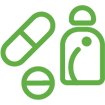
How digital tools are transforming medication adherence in cancer care
Adhering to a cancer medication routine can be challenging for the patient, yet it’s at the heart of their treatment’s success. While traditional ways of clinical practice might seem out-of-date, new technology offers promising solutions to the same age-old problems. Ensuring cancer patients adhere to their prescribed medication regimens is crucial for optimising treatment outcomes and reducing healthcare costs.
Studies indicate that adherence rates for self-administered cancer medications vary widely, averaging around 50% and ranging from 15% to 97%. However, the implementation of smartphone apps, such as the Sciensus Cancer Companion, shows promise in significantly improving adherence rates.
Study overview
A study titled “Using a Smartphone App to Improve Cancer Medication Adherence” was carried out for the whole of 2021 by Rayna Patel with co-authors Serena Popat, Carolina Sportelli, and Chris Fidyk. The investigation looked to explore in what manner a smartphone app may be useful to patients with cancer in tracking their self-administered medications from home. The results from this study accommodates adequate evidence that technological interventions are effective ways to improve medication adherence.
The importance of medication adherence
Adherence to prescribed cancer medications is important to optimise patients’ outcomes and chances of survival. Clinical decline, higher healthcare costs, and reduced treatment effectiveness are results of nonadherence. Though these are in the foreground of importance, the adherence rates for self-administered cancer medications differ for various reasons, but the average rate is about 50%.
Find out more about how our digital solutions help patients overcome adherence challenges, leading to better health outcomes.
Influence of push notifications
This research essentially underlines just how big of a difference small nudges could make in behavioural change. Push notifications act as reminders that go off at the right time, thus making sure patients take their medication as prescribed. Equally, this rather simple tool bridges the gap between prescription and adherence – a basic solution to a complex problem.
The challenge
Most patients with cancer find prescribed medication regimens very hard to adhere to. Treatment regimens are complex in nature and need to be embedded in the daily routine of patients. The traditional approaches toward reminders and support are fairly inadequate, and the variability in adherence can be vast.

The solution: Sciensus Cancer Companion app
Feeling the urge to give more support in compliance, Sciensus offers the Cancer Companion app, which provides reminders to take medication through push notifications at the appropriate time. Integrated with the technology provided, patients are guided to continue managing their medication schedules, hence improving adherence towards better health outcomes.
Benefits for patients and healthcare providers
For patients:
- Improved medication adherence means better health outcomes.
- Increased treatment efficacy, and a higher quality of life.
- Patients are empowered to take control of their health, which can lead to greater confidence in managing their condition.
For healthcare providers:
- The increased adherence rates reduce the demand on nurses and other healthcare professionals for treatment monitoring.
- Allows focus on other critical aspects of patient care, enhancing overall healthcare delivery.
Summary
- Technology’s role in healthcare – The Cancer Companion app shows how technology and health are becoming more integrated to improve patient care.
- Improved medication tracking – The app provides an easy-to-use solution for tracking medication dispensation, benefiting both patients and healthcare professionals.
- Future potential of digital tools – Further studies and assessments will help develop and expand the role of such apps in cancer care.
- Sciensus’ is leading patient-centric innovation – Sciensus is using technology and patient insights to enhance patient experiences and create new commercial opportunities for pharma.



